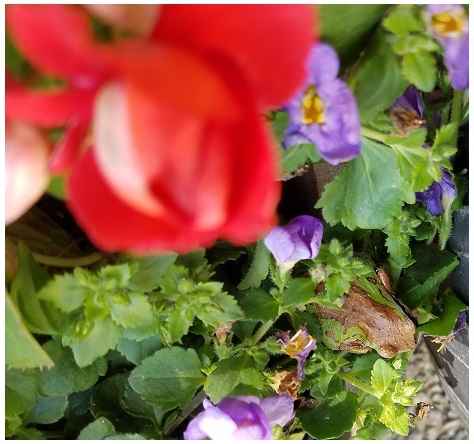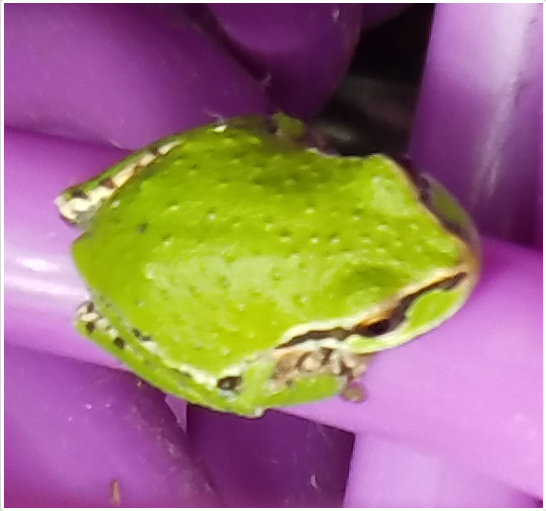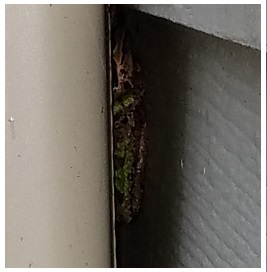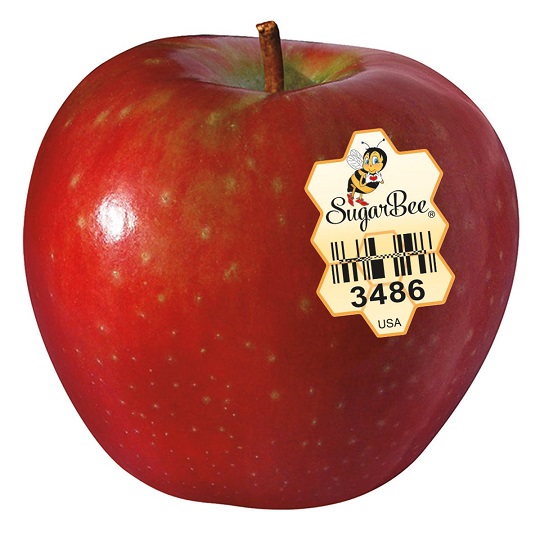The Return of Philamena

Early Monday morning, Mrs. Jones, the silver-haired widow in her sixties who occupies the single-story brick house with the red front door at 213 Patriot Lane, called and with great excitement reported that Philamena has returned. The matriarch of the Pacific tree frog family, Philamena, as she has done in late spring for the last eight years, returned to her residence behind the aluminum gutter downspout just two feet from Mrs. Jones arched front door. Quite by chance, Mrs. Jones spied Philamena, recognizable because of the frog’s large size, exploring a newly planted small wooden container of red and white double-blossom impatiens and trailing lavender-blue bocupa plants. Because of Philamena’s morphing colors, Mrs. Jones did a double take to make sure it was the frog in the planter.
Mrs. Jones was able to capture a picture of Philamena as she leaped out of the container and onto the pebbled sidewalk. Her amphibian form in full display, Philamena shows her decorative, predominately brown body with lots of bumps and a forest green color splashed along the sides of her body and around her large eyes.
Five-year-old Caroline Franks, whose mother, Jackie, frequently assisted Mrs. Jones with housekeeping, looked up at her mother, and in a tiny voice laced with distress, cried, “Where Hilmehah?”
Jackie stooped down and drew Caroline in to a hug saying, “Philamena is out…shopping,” choosing a word her daughter understood.
Looking sad, Caroline said, “Oh.”
Not wanting to further disappoint the crowd, Mrs. Jones pointed to a small brown planter that looked like an old-fashioned barrel. It was positioned under a water faucet.

Mrs. Jones said, “This is where I store my garden hose. It also collects rainwater and water from the nozzle because I never seem to make the connection tight enough.” Some of the younger children, including Caroline, moved closer and peered into the container with the tangled purple garden hose.

“Last summer I stepped out to water my flowers and stopped short when I discovered one of Philamena’s babies lounging on the hose.”
Mrs. Jones reached into the right front pocket of her apron with a picture of a gray cat and pulled out a mobile phone. Then she reached in the left front pocket of the apron and pulled out a half-frame of reading glasses shaped like cat eyes with bling. She swiped at the phone and turned it to show everyone the picture on the screen. Everyone instantly moved in closer amid utterances of wow and ah.
A few of the younger children, like Caroline, reach out to touch the screen. Charlie Drake, the 10-year-old son of postman, Henry, said with exuberance, “I’ve seen that baby…that frog…near our house.”
Mrs. Jones answered, “I have no doubt, Charlie, that you’ve seen a Pacific tree frog. They populate our area. And their rib-bit chorus can be heard throughout our community. I’m happy to share more pictures of Philamena’s offspring. I’ll ask Tarna Cutter to include them with her next blog."
With that, the group departed to pursue other activities. Mrs. Jones dropped her phone and reading glasses back into her apron pockets and waved good-bye to everyone. Before stepping into her house, she looked behind the downspout and spotted Philamena resting in the small space between it and the exterior wall. She smiled, whispered, “See you later,” and then went inside.
To learn more, read the Wikipedia page about the Pacific Tree Frog.



The Post
Welcome to the new online version of the Post for Cutter's Corner. For 20 years, Polly Cutter Floyd wrote and produced the monthly community newsletter that was distributed at P&B’s Market on Main Street. Now retired, my favorite and only paternal Aunt Polly passed the keyboard to me, Tarna Cutter. This is the first issue of the newsletter that I intend to transform into a blog. To make sure community members who want a printed copy of the Post, they'll be placed in the box P&B Market has set aside for it at the end of each week.
Moving forward, I’ll be writing about events that have or will occur in Cutter’s Corner. There also will be short stories published—both fiction and non-fiction to entertain everyone. If you have a story you’d like to share, please reach out to me. Let’s stay connected.